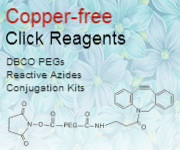High Capacity Acyl-Rac Capture Beads
|
Similar products: Activated thiol Sepharose, activated thiol agarose, thiopropyl Sepharose 6B, thiopropyl activated agarose.
Applications: acyl-RAC protein assays; Protein Palmitoylation; S-Palmitoylation; Palmitoylating;Site-specific protein immobilization.
Description:
High capacity thiol reactive S3 Beads are one of Nanocs reactive agarose beads that can be used for reversible immobilization of biomolecules containing free thiol groups. S3TM thiol capture beads contain sulhydryl reactive bonds that can react easily with free thiol groups under mild conditions. Reaction between thiol and S3 resins results a reversible dithio bond that can be cleaved by common dithio reducing agents such as DTT or TCEP. Compared to other thiol reactive beads, Nanocs S3TM Beads have exceptionally high thiol capture capacity; Density of thiol reactive groups on S3 beads is 20-30 times more over conventional thiol activated agarose beads. S3 beads can be used in many applications, such as acyl-RAC protein assays; Protein palmitolyation research; Site-specific protein immobilizations; Protein purification, digestion and analysis. S3 beads are ideal replacements for commonly used activated Thiol-Sepharose 4B or Thiopropyl Sepharose 6B from GE.
Product Features:
- High thiol binding capacity;
- Superior thiol reactivity:
- Reversible disulfide linkage;
- Low non-specific binding;
Product Specification:
- Bead Matrix: 6B pegylated agarose beads;
- Bead Size: 50~150 microns;
- Ligand type: Thiol reactive ligands;
- Ligand density: 800-1000 umol/g beads;
- Reactive to: Free sulfhydryl/thiol groups (cystein, etc.);
- Form: 50% aqueous suspension.
Storage Conditions:
- Store at 4-8 0C.
Acyl-rac Related Reagents:
- DTT (Dithiothreitol)
- TCEP.HCl
- Hydroxylamine
- Ellman's reagent
- mPEG Maleimide
References:
Motipally, S. I., Myers, B., Sechrest, E. R., Sokolov, D., Murphy, J. and Kolandaivelu, S. (2023). A Modified Acyl-RAC Method of Isolating Retinal Palmitoyl Proteome for Subsequent Detection through LC-MS/MS. Bio-protocol 13(8): e4654. DOI: 10.21769/BioProtoc.4654.


